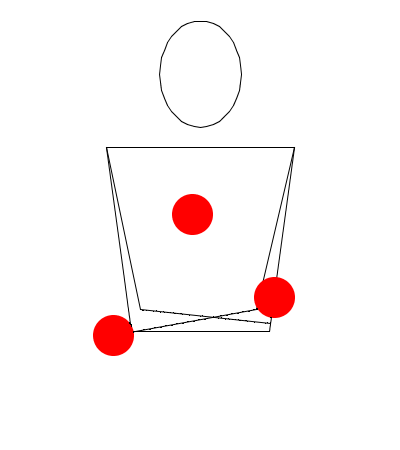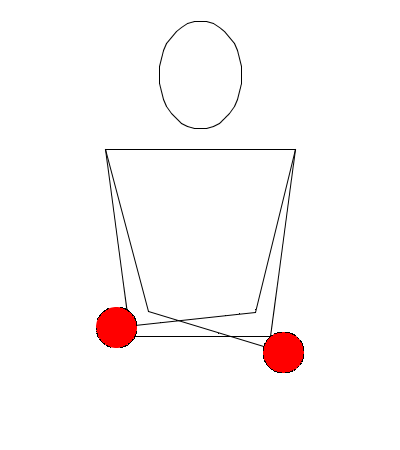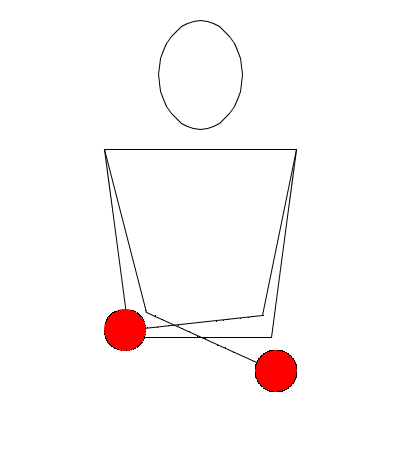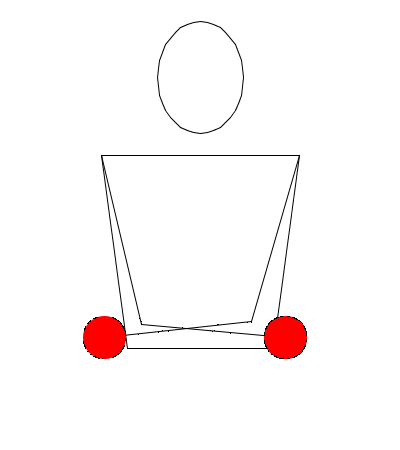Icelandic Shuffle
Other Tutorials:
- Siteswap: 33333342
- Difficulty (1-10): 5
- Prerequisites: Georgian Scuffle or Kraken

The Icelandic Shuffle is a
three ball pattern that I believe was established by
Beejay Joyer. It can
basically be seen as an asymmetric variation of the Kraken, in which one
ball is carried around the pattern in order to set up the next cycle. Like
the Kraken, the Icelandic Shuffle uses midair stalls, though it has
a more uneven pace than its symmetric counterpart.
To begin learning the Icelandic Shuffle, start with two balls
in your dominant hand and one ball in your non-dominant. Cross your arms
such that your dominant hand is underneath your non-dominant hand, and then
make a vertical throw from your dominant hand. Immediately after, throw the ball in your non-dominant hand straight up, and then continue the
upward motion of your hand and direct it toward the ball thrown from your
dominant hand. You will claw catch the ball with your non-dominant hand
(leaving it suspended in midair), and
then make a vertical throw along the center of your body using your dominant
hand, clearing space for that hand to catch the ball thrown from your
non-dominant hand. You will then release the ball in your non-dominant hand
(which is being held in the air), and claw catch the the center ball as it
reaches its peak and begins to descend. The ball you released will be caught
by your dominant hand.
Next, you are going to change the way you catch the final
ball of the previous step. Instead of simply crossing your dominant hand and
catching the ball as it descends, you are going to make a throw from your
dominant hand on the dominant side of your body toward the center of your
body, and then cross your dominant hand over and claw catch the other ball
out of the air (the ball you simply let fall into your dominant hand at the
end of the previous step). As the ball thrown from your dominant hand travels
toward the center of your body, you are going to make a throw from your
non-dominant hand underneath that ball, toward the dominant side of your
body. This will clear space for your non-dominant hand to catch the ball
thrown from your dominant hand. You will then also catch the ball thrown
from your non-dominant hand with your non-dominant hand.
Notice in the animation above that one of the hands (your
dominant hand) stays stuck awkwardly in the air after it claw catches one of
the balls. For the final step, your are going to swing that ball over the
top of the pattern as your non-dominant hand is making its throw (the last
throw of the previous step). As that ball thrown from your non-dominant hand
descends, you are going to make another throw from your non-dominant toward
the center of your body (biased a bit toward the dominant side of your
body). This will clear space for your non-dominant hand to catch the ball it
threw previously. By this point your dominant hand should have finished
its arc around the pattern, where it will end up crossed under your
non-dominant hand (back where it started). You will then use it to catch the
ball just thrown from your non-dominant hand.
You have just completed one full cycle of the Icelandic
Shuffle. To continue the pattern, simply make an underarm throw from your
dominant hand after it crosses underneath your non-dominant hand. This will
clear space for the hand to catch the final ball from the last cycle and
also
create the first throw of the new cycle. The Icelandic Shuffle is a
fast-paced, compact pattern that will take a lot of practice to fully
control. Once mastered however, it becomes a enjoyable pattern to both watch
and juggle.
